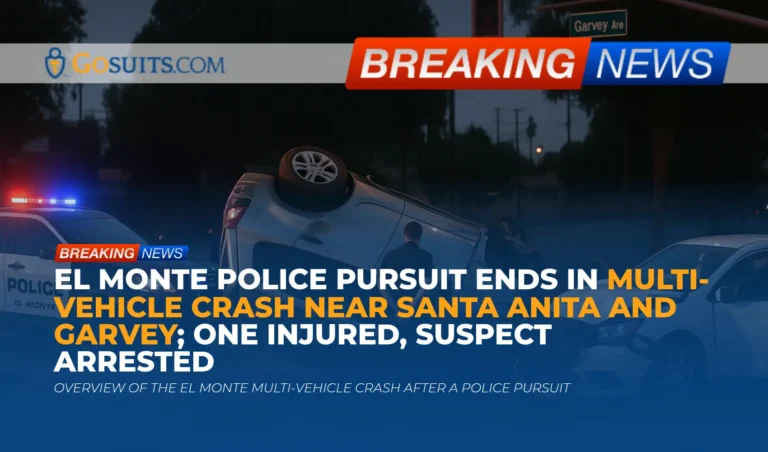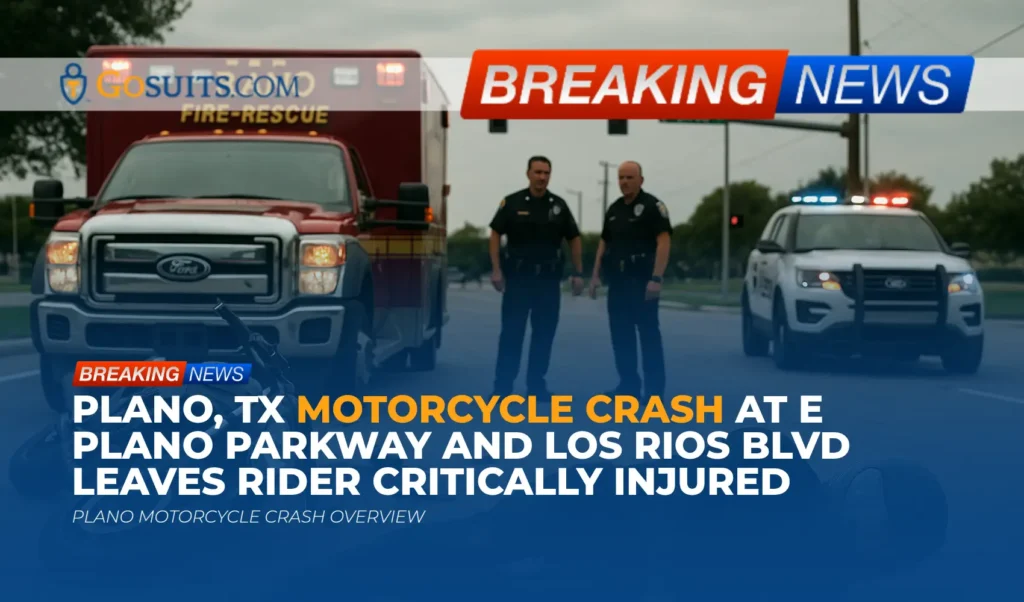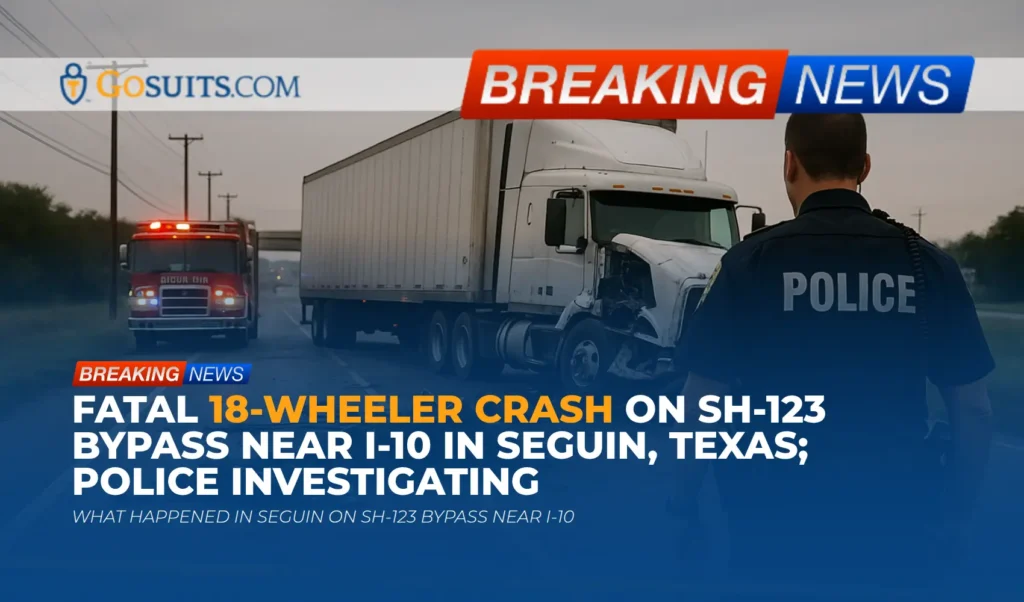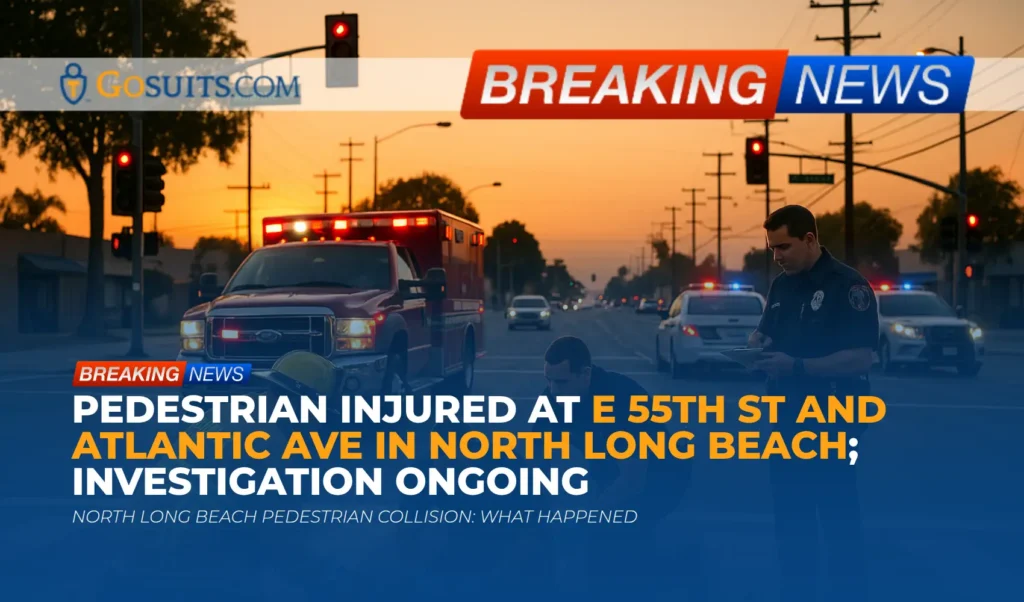- Overview of the El Monte multi-vehicle crash after a police pursuit
- What authorities have reported so far
- Rights and options for those affected by a police-pursuit crash in California
- Potential civil liability and how fault may be allocated
- California pursuit policies and governmental immunity overview
- Evidence and documentation to gather immediately
- Medical care and symptom watch after a crash
- How to obtain official records and reports
- Insurance pathways and claims considerations
- Deadlines and time limits in California claims
- Practical next steps after a serious crash
- Community safety and policy considerations
- Call to Action: Steps to safeguard health, rights, and recovery
- Commentary from Gosuits El Monte, California Personal Injury Attorney
Overview of the El Monte multi-vehicle crash after a police pursuit
Late Tuesday night in El Monte, a police pursuit that lasted roughly 20 minutes ended in a multi-vehicle collision near Santa Anita Avenue and East Garvey Avenue. According to statements referenced by local reporting, the chase concluded when the fleeing driver crashed into two other cars. At least one vehicle was left flipped on its side, and one person sustained injuries but declined further treatment at the scene. The person who allegedly fled was taken into custody. As of now, additional details have not been made public by the El Monte Police Department.
For community members and families, incidents like this are frightening and disorienting. Even when visible injuries seem minor, the physical and emotional impacts of a crash can surface later. This article explains what is known, what steps may be available to those affected, and how California law addresses civil responsibility in collisions connected to police pursuits. It also provides links to governmental resources for reports and support.
What authorities have reported so far
Based on initial accounts, the pursuit began shortly after 10 p.m. and ended when the suspect vehicle collided with two other cars in the area of Santa Anita Avenue and East Garvey Avenue in El Monte. Video from the scene reportedly showed substantial vehicle damage and one car on its side. The El Monte Police Department indicated one person was hurt and declined further treatment. The suspect was reportedly on probation, and was taken into custody. No official public release with extended details was available at the time of writing.
When official updates are published, they typically come from the city police department or, in some cases, county or state agencies depending on who leads the investigation. For El Monte incidents, the primary agency is usually the El Monte Police Department.
Rights and options for those affected by a police-pursuit crash in California
People affected by a crash linked to a police pursuit have the same core rights as any collision victim, with additional considerations due to the involvement of law enforcement activities. In most cases, those harmed by the fleeing driver can pursue civil compensation from that driver’s insurance and, if appropriate, other responsible parties.
There are several pathways that may apply, depending on the facts:
- Claims against the fleeing driver: The at-fault driver who initiated or escalated the danger can be liable for injuries, vehicle damage, and other losses.
- Uninsured or underinsured motorist coverage: If the fleeing driver lacks adequate insurance, one’s own auto policy may provide coverage through UM or UIM benefits.
- Medical payments coverage: Some policies include “med pay” that can help with medical expenses regardless of fault.
- Public entity considerations: In limited circumstances, a claim may be evaluated against a public entity when specific legal criteria are met. California law provides immunities and requirements for pursuit policies and training that can affect these claims.
Each route has different rules, deadlines, and evidentiary needs. Because insurance and governmental immunities can be complex, it is important to understand the available options before making statements to insurers.
Potential civil liability and how fault may be allocated
California uses comparative fault principles for personal injury cases, which means each party can be assigned a share of responsibility based on their actions. The fleeing driver’s liability is often central, since initiating or continuing dangerous flight can breach the duty of care to others on the road. If multiple vehicles were involved, there may be multiple insurers and claim files.
In a typical scenario:
- Fleeing driver’s insurer: Primary target for third-party claims if coverage exists.
- Multiple impacted drivers: Separate claims may be necessary for each vehicle and person injured.
- Governmental agencies: Liability analysis is fact specific. California law includes immunities for personnel and agencies during pursuits if strict statutory conditions are met.
- Other third parties: Vehicle owners, employers, or commercial entities may be implicated in limited circumstances, for example if the fleeing driver was operating an employer’s vehicle within scope of employment.
The role of immunities and pursuit policies is significant in any evaluation of a public entity’s exposure. Whether any such exposure exists depends on the pursuit policy in place, training, and whether responding personnel complied with required standards.
California pursuit policies and governmental immunity overview
California law addresses the operation of emergency vehicles and pursuit policies. Two Vehicle Code sections are frequently relevant:
- Vehicle Code section 17004: Provides that a public employee is generally immune from civil liability for injuries caused while operating an authorized emergency vehicle in immediate pursuit or response, provided certain conditions are met. See the statutory text at leginfo.legislature.ca.gov.
- Vehicle Code section 17004.7: Provides conditional immunity to public agencies if they adopt and implement a compliant written vehicle pursuit policy and provide regular training to officers. The statute outlines policy content requirements. See the statutory text at leginfo.legislature.ca.gov.
The California Commission on Peace Officer Standards and Training publishes guidance on vehicle pursuits, which agencies use to structure policy and training. These guidelines emphasize balancing the need to apprehend a suspect with the safety of uninvolved motorists and pedestrians. See California POST’s vehicle pursuit publication at post.ca.gov.
In practice, whether a government entity can be held civilly liable turns on careful legal and factual analysis. This includes the content of the agency’s written policy, how training was conducted, and whether the policy was followed in the specific pursuit. California’s Government Claims Act also imposes strict claim-filing deadlines for any claim against a public entity.
Evidence and documentation to gather immediately
Evidence often shapes the outcome of an injury claim. After a multi-vehicle crash related to a pursuit, time-sensitive items can include:
- Photographs and video: Scene, vehicle positions, debris fields, skid marks, property damage, and any visible injuries.
- Witness information: Names and contact details for bystanders, business employees, or other drivers.
- Surveillance footage: Nearby businesses, residences, and traffic cameras may have captured the pursuit or collision. Politely ask managers or owners to preserve footage.
- Event Data Recorder (EDR): Many vehicles capture pre-crash data such as speed and braking. Preserving the vehicle before repairs can be crucial.
- 911 calls and radio traffic: These can be requested from the investigating agency, sometimes through a public records request.
- Body-worn camera and dash camera material: Where available, these may be subject to public records rules with exemptions.
- Medical records: Even if treatment was declined at the scene, later clinical evaluations and diagnostic records document injury progression.
If a vehicle is towed, document the tow yard location and any paperwork. Avoid authorizing repairs until inspections and photographs are complete, especially if liability is contested.
Medical care and symptom watch after a crash
Declining treatment on scene does not preclude experiencing injury symptoms later. Adrenaline and shock can mask pain and cognitive changes. If any new or worsening symptoms emerge, seek medical care promptly. Warning signs can include persistent headaches, neck pain, confusion, dizziness, nausea, sleep disturbance, emotional changes, or numbness and tingling. The Centers for Disease Control and Prevention provides information on recognizing and managing head injury symptoms at cdc.gov.
Follow-up care, including primary care visits, urgent care, or emergency evaluation, can document injuries and provide treatment plans. Keep all receipts, visit summaries, prescriptions, and therapy notes. Consistent documentation supports both recovery and any necessary claims.
How to obtain official records and reports
Official records help clarify what happened and are often required by insurers. Depending on the investigating agency and the type of document, different processes apply.
Police collision report
For incidents within the City of El Monte, records are handled by the El Monte Police Department. Information on requesting police records is available through the city’s official website at elmonteca.gov. Collision reports are typically limited to involved parties, their insurers, and legal representatives. Identification and proof of involvement are usually required.
California DMV accident reporting
California requires the filing of an SR-1 Report of Traffic Accident with the Department of Motor Vehicles within 10 days if anyone is injured or if property damage exceeds a statutory threshold. Details and the form are provided by the California DMV at dmv.ca.gov.

California Highway Patrol reports
If the California Highway Patrol was the investigating agency for any portion of the incident, collision reports can be requested through CHP. Instructions are posted at chp.ca.gov. For this El Monte incident, the local city police appear to be the primary investigating agency.
Medical Examiner and autopsy records
In crashes involving fatalities, families can request information from the Los Angeles County Department of Medical Examiner. Guidance on requesting reports is available at mec.lacounty.gov.
Victim support services
Those affected by a crime linked to the incident may qualify for victim assistance resources. Two helpful government sources are:
- Los Angeles County District Attorney Victim Services: Information and support for crime victims at da.lacounty.gov.
- California Victim Compensation Board: Potential financial assistance for qualifying out-of-pocket expenses related to violent crime at victims.ca.gov.
Insurance pathways and claims considerations
Insurance recoveries often involve multiple components. It is common for individuals to have questions about which coverage applies first and how to avoid mistakes in early communications. Consider the following:
- Speak with a qualified attorney before contacting insurers: Initial statements to insurance companies can be recorded and may be used to limit or dispute a claim later. Consulting counsel first can help set a plan and avoid missteps.
- Third-party liability claim: Usually opened against the fleeing driver’s policy for medical bills, lost income documentation, vehicle repairs, and other losses.
- Uninsured or underinsured motorist claim: If the at-fault driver has no or insufficient insurance, UM or UIM through one’s own policy may help.
- Medical payments coverage: This no-fault component may pay eligible medical costs up to the purchased limit.
- Property damage and rental: Collision coverage and rental reimbursement, if purchased, can provide vehicle repair or total loss benefits and temporary transportation.
- Health insurance coordination: Health plans may pay medical costs up front and assert reimbursement rights at settlement. Keep explanation of benefits documents.
Keep a claim diary noting dates, adjuster names, claim numbers, and summaries of each communication. Save all estimates, invoices, and photographs. Do not agree to a quick settlement before the full scope of injuries and property damage is known.
Deadlines and time limits in California claims
California law imposes strict time limits for civil claims. Although each case differs, two general rules often apply:
- Government Claims Act deadline: Claims for money or damages against a public entity generally must be presented no later than six months from the accrual of the cause of action for injury to person or personal property. See California Government Code section 911.2 at leginfo.legislature.ca.gov.
- General personal injury statute of limitations: In many California personal injury cases not involving a public entity as the defendant, a two-year limitations period applies. See Code of Civil Procedure section 335.1 at leginfo.legislature.ca.gov and overview resources from the California Courts at courts.ca.gov.
Deadlines may be longer or shorter depending on the parties involved and the type of claim. Preserving rights requires attention to these time limits and to any notice requirements.
Practical next steps after a serious crash
When a pursuit-related crash disrupts life, having a plan can make a difference in health and recovery. These steps are general and may be adjusted based on individual circumstances:
- Seek medical evaluation: If symptoms evolve, visit a healthcare provider to document and treat injuries.
- Preserve evidence: Photograph vehicles and injuries, secure dashcam or surveillance footage, and track witness information.
- Request official records: Obtain the police collision report from the City of El Monte if you are an involved party. Consider requesting 911 audio, radio traffic, and any available video through proper channels. See elmonteca.gov.
- Document all expenses: Keep receipts for medical care, mobility aids, prescriptions, and vehicle-related costs.
- Before speaking with insurers, consult an attorney: Early guidance can help prevent statements that may be misconstrued. What is said to insurers can be used to contest a claim later.
- Consider DMV obligations: If required, file the SR-1 with the DMV within 10 days. See dmv.ca.gov.
Community safety and policy considerations
Police pursuits are dynamic and high risk. California’s policy framework, including the required content of pursuit policies and the focus on training, aims to reduce harm to bystanders while enabling law enforcement to respond to dangerous conduct. California POST’s guidelines acknowledge the need to continually assess pursuit necessity against the risks to the public, the officers, and the suspect. See post.ca.gov.
When a crash occurs, communities rightly ask how and why it happened. In many cases, the primary civil responsibility lies with the fleeing motorist whose choices triggered the hazard. At the same time, careful review of facts and adherence to policies are necessary to assess whether all required safeguards were followed during the pursuit.
Call to Action: Steps to safeguard health, rights, and recovery
Here are focused steps to take that can protect well-being and legal interests after a pursuit-related collision:
- Prioritize health now: Schedule follow-up medical care even if you felt okay at the scene. Some injuries present hours or days later. Early evaluation improves outcomes and documentation.
- Secure records quickly: Request the collision report and any available recordings as soon as eligible. Records can be time-limited, and some audio or video may be overwritten if not preserved promptly.
- Organize evidence: Create a folder with photos, medical visits, bills, pay stubs showing lost time, and communications with insurers. A clear paper trail supports fair evaluation of losses.
- Be cautious with insurers: Before giving any recorded statement, consult an attorney for a free consultation to understand rights and obligations. Statements can be used later to challenge claims.
- Track deadlines: Calendar the 10-day DMV SR-1 requirement if applicable, and note potential six-month government claim deadlines. Missing a deadline can limit options.
- Seek supportive services: If the incident is connected to a crime, explore resources from the Los Angeles County District Attorney’s Victim Services and the California Victim Compensation Board for potential assistance.

Commentary from Gosuits El Monte, California Personal Injury Attorney
Our thoughts are with everyone affected by the late-night multi-vehicle collision near Santa Anita Avenue and East Garvey Avenue. Collisions tied to pursuits are sudden, frightening, and can have lingering effects even when injuries are not obvious at first. This article is intended for educational purposes, to help community members understand general rights and steps available under California law.
Based on publicly reported information, a fleeing driver collided with other vehicles after a 20-minute pursuit. In situations like this, civil responsibility most often focuses on the fleeing driver, whose choices put others at risk. California’s legal framework also recognizes the importance of clear pursuit policies and training for agencies, which can factor into the legal analysis when public entities are involved. Determining who bears responsibility requires careful review of the facts, the pursuit policy, and available evidence such as reports, 911 audio, and any camera footage.
Insurance companies and corporate claim departments commonly act quickly after an incident. They may seek statements, request broad medical authorizations, or offer early settlements. People unfamiliar with the process may inadvertently say things that are later used to dispute fault or minimize injury. Adjusters also scrutinize gaps in care, encouraging quick closures before the full scope of harm is understood. Being informed and deliberate about communications helps prevent avoidable setbacks.
A free consultation can help clarify options without commitment or cost. It allows a discussion of insurance coverage layers, potential government claim deadlines, and the best steps to preserve evidence. Even if someone chooses not to move forward with a claim, understanding time limits and documentation needs can protect their interests while they focus on recovery.
Key government resources referenced
- City of El Monte Police Department for collision report and records information.
- California DMV SR-1 accident reporting for state reporting requirements.
- Vehicle Code § 17004 and Vehicle Code § 17004.7 for emergency vehicle and pursuit policy immunities.
- Government Code § 911.2 for public entity claim deadlines.
- Code of Civil Procedure § 335.1 for general personal injury time limits.
- California POST Vehicle Pursuit Guidelines for policy and training context.
- Los Angeles County Department of Medical Examiner for information on autopsy and records in fatal incidents.
- Los Angeles County DA Victim Services and California Victim Compensation Board for victim support resources.
- California Courts Self-Help: Personal Injury for general civil process information.
- CDC head injury signs and symptoms for medical guidance on when to seek care.






